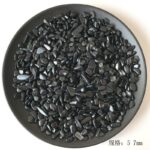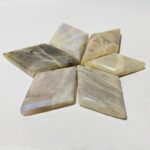Introduction
Quartz, a ubiquitous mineral composed primarily of silicon and oxygen, captivates with its diverse hues and remarkable properties. This versatile stone finds applications in a vast array of industries, ranging from jewelry and electronics to construction and medicine. Delve into the intriguing realm of quartz to uncover its unique characteristics, fascinating history, and countless benefits.

Types of Quartz
The quartz family boasts an impressive array of varieties, each with its distinct attributes:
- Crystalline Quartz: Featuring a hexagonal crystal structure, this transparent variety is widely used in jewelry and spiritual practices.
- Amethyst: A captivating purple variety that owes its color to trace amounts of iron.
- Citrine: A vibrant yellow variety often associated with abundance and prosperity.
- Ametrine: A captivating blend of amethyst and citrine, showcasing a unique purple and yellow combination.
- Rose Quartz: A delicate pink variety believed to promote love and harmony.
- Smoky Quartz: A translucent brown variety known for its grounding and protective qualities.
- Clear Quartz: A transparent variety that amplifies energy and is often used for healing purposes.
- Milky Quartz: An opaque white variety that promotes clarity and purification.
History and Folklore
Quartz has a rich history dating back thousands of years. Ancient civilizations believed in its mystical powers and used it for various purposes, including divination, healing, and protection.
In Chinese medicine, quartz is believed to balance the body’s energy flow, while Ayurvedic practitioners use it to treat various ailments. Native American tribes revered quartz as a sacred stone and incorporated it into their spiritual ceremonies.
Properties and Uses
Quartz possesses a unique combination of properties that make it a valuable material in various applications:
- Hardness: Quartz is one of the hardest minerals, with a Mohs hardness of 7, making it resistant to scratching.
- Piezoelectricity: Quartz crystals generate an electrical signal when subjected to pressure, a property utilized in electronic devices.
- Optical Properties: Quartz is highly transparent and used for lenses, prisms, and optical fibers.
- Thermal Stability: Quartz has a high melting point, making it suitable for high-temperature applications.
Jewelry and Decorative Arts
Quartz’s stunning beauty and durability have made it a popular choice for jewelry makers. Amethyst, citrine, and rose quartz are particularly sought after for their vibrant hues. Quartz is also carved into figurines, beads, and decorative objects.
Electronics and Technology
Quartz’s piezoelectric properties make it essential in electronic devices, including watches, clocks, and sensors. It is also used in lasers, fiber optics, and telecommunications.
Construction and Industrial Applications
Crushed quartz is widely used in construction as an aggregate for concrete, asphalt, and road surfaces. It is also used in countertops, flooring, and tiles. Quartz’s high melting point makes it suitable for refractory materials in furnaces and kilns.
Medicine and Healing
Quartz is believed to have healing properties, and some proponents claim it can:
- Improve mental clarity
- Reduce stress and anxiety
- Promote physical healing
- Strengthen the immune system
While scientific evidence to support these claims is limited, quartz is often used in alternative therapies, such as crystal healing and reiki.
Benefits of Quartz
Incorporating quartz into your life offers numerous benefits:
- Spiritual and Emotional Healing: Quartz is believed to enhance spiritual connection, promote emotional balance, and shield against negative energies.
- Physical Well-being: Proponents claim quartz can boost energy levels, reduce pain, and support the immune system.
- Aesthetic Value: Quartz’s dazzling colors and textures add beauty and elegance to surroundings.
- Practical Applications: Quartz’s versatility extends from electronics to construction, offering practical solutions in various industries.
Common Mistakes to Avoid
To fully appreciate the benefits of quartz, avoid these common mistakes:
- Over-reliance on Gemstones: While quartz may be beneficial, it should not replace medical advice or treatment.
- Inappropriate Storage: Store quartz in a dry, protected place to prevent scratches and damage.
- Exposure to Extreme Temperatures: Avoid exposing quartz to extreme heat or cold, as it may alter its properties.
- Insufficient Cleansing: Regularly cleanse quartz to remove negative energies and maintain its beneficial properties.
Future Applications
The versatility of quartz inspires ongoing research and development, opening new avenues for innovation:
- Nano-Crystalline Quartz: Advances in nanotechnology have enabled the creation of nano-crystalline quartz, enhancing its optical and electronic properties.
- Biocompatible Quartz: Researchers are exploring the potential of biocompatible quartz for medical applications, such as drug delivery and tissue engineering.
- Flexible Quartz: Novel manufacturing techniques are pushing the boundaries of quartz by creating flexible and wearable forms that expand its applications in electronics and biomedical devices.
Conclusion
Quartz is a captivating and multifaceted mineral that has charmed civilizations for centuries. Its unique properties and diverse varieties make it an invaluable material in a wide range of industries. Quartz not only imparts aesthetic beauty but also offers potential benefits for spiritual, emotional, and physical well-being. As technology advances, the versatility of quartz is set to expand, opening up exciting possibilities for future applications. Embrace the enchanting world of quartz and unlock its boundless potential.
Additional Information
Table 1: Physical Properties of Common Quartz Varieties
| Variety | Color | Transparency | Hardness (Mohs) |
|---|---|---|---|
| Crystalline Quartz | Colorless | Transparent | 7 |
| Amethyst | Purple | Translucent to opaque | 7 |
| Citrine | Yellow | Translucent to opaque | 7 |
| Ametrine | Purple and yellow | Translucent | 7 |
| Rose Quartz | Pink | Translucent | 7 |
| Smoky Quartz | Brown | Translucent | 7 |
| Clear Quartz | Colorless | Transparent | 7 |
| Milky Quartz | White | Opaque | 7 |
Table 2: Applications of Quartz in Different Industries
| Industry | Application |
|---|---|
| Jewelry | Beads, pendants, carvings |
| Electronics | Watches, clocks, sensors |
| Construction | Concrete, asphalt, countertops |
| Telecommunications | Fiber optics, lasers |
| Medicine | Alternative therapies, healing crystals |
Table 3: Potential Benefits of Quartz
| Benefit | Claim |
|---|---|
| Spiritual and Emotional Healing | Enhances spiritual connection, promotes emotional balance, shields against negative energies |
| Physical Well-being | Boosts energy levels, reduces pain, supports the immune system |
| Aesthetic Value | Adds beauty and elegance to surroundings |
| Practical Applications | Offers versatility in electronics, construction, and more |
Table 4: Common Mistakes to Avoid with Quartz
| Mistake | Consequence |
|---|---|
| Over-reliance on Gemstones | May delay or prevent necessary medical treatment |
| Inappropriate Storage | Can lead to scratches and damage |
| Exposure to Extreme Temperatures | May alter quartz’s properties |
| Insufficient Cleansing | Can accumulate negative energies, reducing its beneficial effects |




























